I do not typically visit museums, but when I do, it is either part of a school trip, or a spontaneous side-activity on vacation. Needless to say, I am not much of an art fanatic, so the idea of spending a Sunday morning at the Museum of Modern Art did not seem too appealing. In the past, I have never been able to seriously approach artwork in the given setting because I view it as a hobby rather than the generally accepted conception of a constant “hidden meaning”. Therefore, stepping into the vast array of displays within the MoMA, I told myself that I would attempt to consider everything through an unbiased perspective, trying to understand the so-called “deeper meaning” and “communication” of art. Unfortunately, my perspective remained unchanged, as almost every floor filled me with laughter. The reason I say “almost” is because despite my inability to accept the fact that every piece of artwork contains an indisputable underlying significance, I still appreciate the effort that certain artists invest into the production of their works. There were definitely certain views that looked pleasant, however the overwhelming majority, at least in my opinion, consisted of work that could either be recreated by children, viewed online, or simply not even viewed at all.
Hanes, Inc. White T-Shirt. 1910s
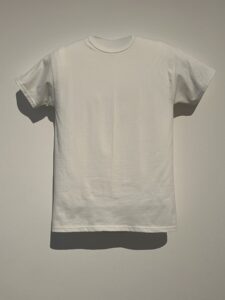
I began with the second floor. The first piece that shocked me was the White T-Shirt by Hanes, Inc. My immediate instinct was to laugh at the thought of a plain, white t-shirt hanging on display at a museum that international tourists come to visit. Upon further analysis, I noticed that the shirt conveyed noteworthy history. A plain shirt does not randomly appear in a store. It undergoes multiple procedures, from the manufacturing of yarn from cotton, into textiles, imported into warehouses, and so on until they are ultimately packaged and shipped. Labor activist, Kalpona Akter, shares, “When you buy a t-shirt, it just costs you $5 or $10. But no one talks about the workers who made them.” She proceeds to note that the minimum wage in Bangladesh is $95 a month, a fact that is extremely unfortunate and almost unbelievable. Overall, the presence of the shirt indicates the history behind its production, such as the unjust treatment of factory workers regarding their unfair wages and isolation from fundamental rights. Akter urges the audience to not feel sad, but rather feel angry in such a way that allows the use of this emotion toward making a difference for people. “If there is injustice, someone always can stand up and speak out. If there is someone, why not you? You have the power to make that change.” After delving into this context, I definitely found the piece eye-opening, crucial, and considerably empowering, as it caused me to think of the abundance of clothes purchased that have been “Made in Bangladesh”, along with the privileges I may take for granted on a daily basis, yet those of which are not accessible to other populations of the world. Although there is a proven “message” within the white t-shirt, I believe that placing it in an art museum is unnecessary as well as unfitting, for the information conveyed to me through the display of this cloth could have been communicated through simpler means.
Salvador Dalí. The Persistence of Memory. 1931

Having briefly previewed the exhibitions of the MoMA prior to arrival, I paced around the museum searching for a specific work of art, Salvador Dali’s The Persistence of Memory. The reason I was eager to find this painting was because of two reasons. Firstly, as part of an elective requirement during the sophomore year of high school, I took an art class during which I remember learning about Salvador Dalí and his niche of surrealism, being presented with this exact painting. Secondly, the summer of that same year, I visited St. Petersburg, Florida, and coincidentally came upon The Dalí Museum, which happened to be one of the main tourist attractions within this small city. So, I walked around the same way I did in the MoMA, treating the artwork frivolously and with comedy, however leaving with a sense of dissatisfaction that The Persistence of Memory in this museum was not an original work. Hence, I did feel a sense of fulfillment when I finally found the real painting I had already been familiar with and learned about, at this museum. It was truthfully underwhelming in appearance due to its small size and disrupted visual appearance, caused by glares and dim lighting. Examining the history of this painting, one learns that surrealists were a revolutionary movement with a goal of destabilizing political, societal, and cultural norms. Apparently, Dalí liked the state of becoming and unbecoming, which is expressed through the decay-like essence of the melting watches and the flies that surround them.
Andrew Wyeth. Christina’s World. 1948
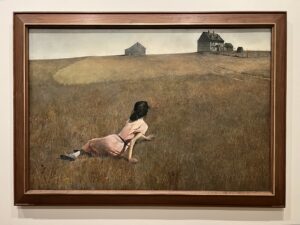
Unintentionally, I stumbled upon Andrew Wyeth’s Christina’s World, which was placed within a narrow passageway, leading from one section of the fifth floor to the other. Coincidentally, this also caught my attention among the arrangement of plentiful other bores, for it was also taught within the same sophomore year art class previously mentioned. It felt nice and somewhat rewarding to be familiar with the foundational circumstances of this painting prior to reading further about it. This painting is inspired by Wyeth’s neighbor, Christina Olsen, who was victim to a neurodegenerative disease, losing the ability to walk by the time of her late 20s. Christina resisted the aid of a wheelchair or crutches, choosing to propel herself with the sole support of her arms. I found this background of Christina’s challenging life exceptionally inspirational. A fact I did not know was that the depicted figure is only partially that of Christina’s, for Wyeth’s wife was used as a model for the hair, torso, and some of the arms. This undeniably raises ethical concerns, as viewers question the implication of a disabled individual’s experience being modified by the depiction of someone who is younger and in a non-disabled body.
Overall, there was a lack of personal connection between myself and the exhibited artworks. I found this trip around the MoMA fairly meaningless, as none of the works particularly resonated with me, however an activity that I enjoyed significantly more than viewing the displays was analyzing other visitors, some of which were tourists, students, or regular locals. It is always interesting to detect the substantial distinction between how others approach art in comparison to myself.

For instance, I walked into a room filled with art that looked like nothing more than a bunch of vibrantly colorful drawings, only to be met with a man that was sitting right in front of the piece, dissecting every, arguably nonexistent, detail. It almost seemed as though he was being engulfed by the world of these paintings, which only seemed like insignificant colors to me, and that in itself, was a more captivating sight than any of those I had previously walked many stairs to look at.

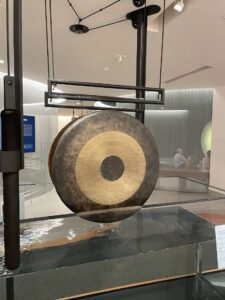
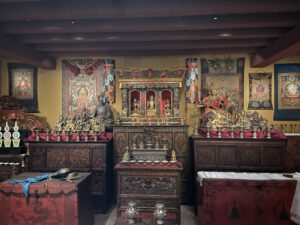
 ♥A Day’s Beginning♥
♥A Day’s Beginning♥
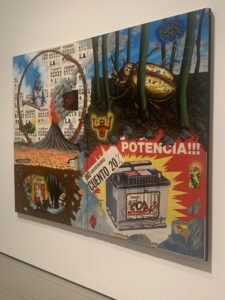

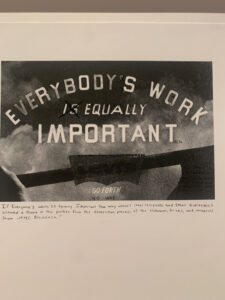


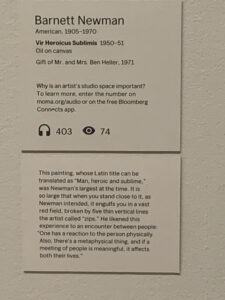




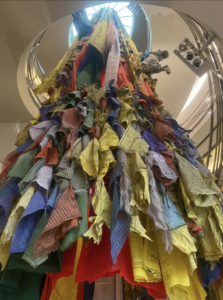
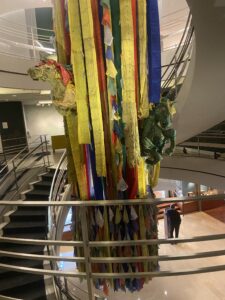
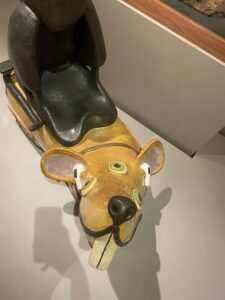


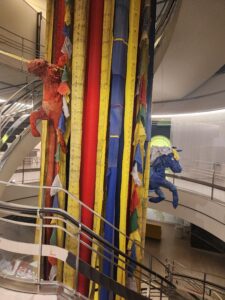
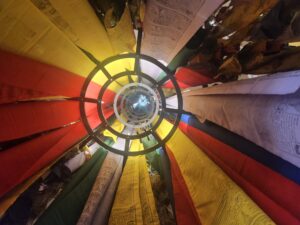
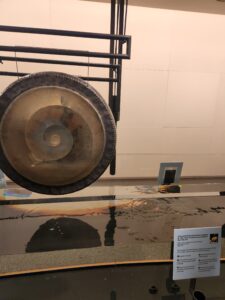


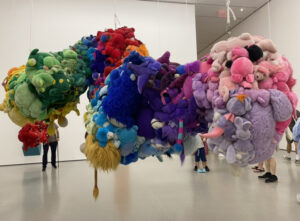 d repressed trauma.
d repressed trauma.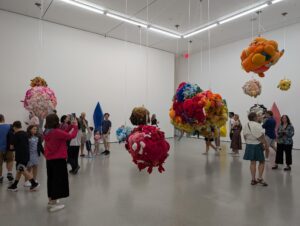
 At first glance I found that the painting suggests that we are blinded by our desperate desires, leading us to push and impose the illusion of our greatest longings upon others or to selfishly embrace a distorted vision of those closest to us. After meditating on this work for a few minutes, I felt an impending revelation that perhaps The Lovers are trying to warn us of the unease in being unable to unveil the depth and truth of even the closest people in our lives and consequently constraining us to love a lie fed to us, an illusion of who they truly are. This poses a compelling question and leads the audience to wonder whether or not we truly connect with the people in our lives, or merely entangled in a web of illusion and a facade they force us to believe and love? Furthermore, the work explores the paradox of our yearning for love while grappling with the fabrications from our partner, as despite it all, we long and hunger to be wanted and accepted. For this reason, we push forth despite the pain and suffocation accompanying the mystery in our partner and secrets they may hold. Their true intention may be concealed, nevertheless you accept what is being offered in the moment due to the comfort in the passion they offer and the solace in their deception, despite knowing that you are alone in a partnership, trapped, and struggling to breathe.
At first glance I found that the painting suggests that we are blinded by our desperate desires, leading us to push and impose the illusion of our greatest longings upon others or to selfishly embrace a distorted vision of those closest to us. After meditating on this work for a few minutes, I felt an impending revelation that perhaps The Lovers are trying to warn us of the unease in being unable to unveil the depth and truth of even the closest people in our lives and consequently constraining us to love a lie fed to us, an illusion of who they truly are. This poses a compelling question and leads the audience to wonder whether or not we truly connect with the people in our lives, or merely entangled in a web of illusion and a facade they force us to believe and love? Furthermore, the work explores the paradox of our yearning for love while grappling with the fabrications from our partner, as despite it all, we long and hunger to be wanted and accepted. For this reason, we push forth despite the pain and suffocation accompanying the mystery in our partner and secrets they may hold. Their true intention may be concealed, nevertheless you accept what is being offered in the moment due to the comfort in the passion they offer and the solace in their deception, despite knowing that you are alone in a partnership, trapped, and struggling to breathe.

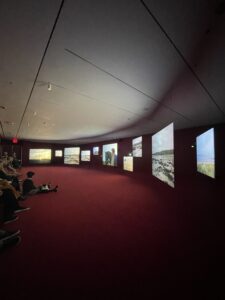
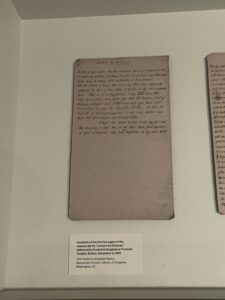

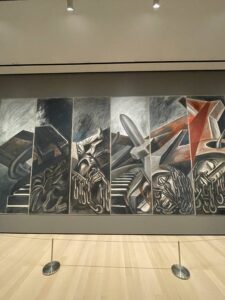
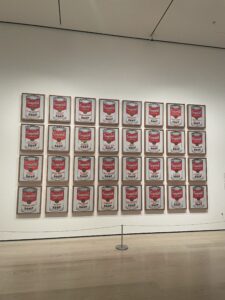
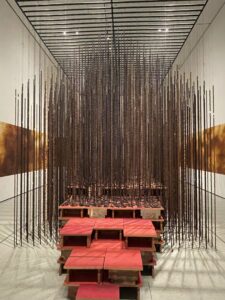
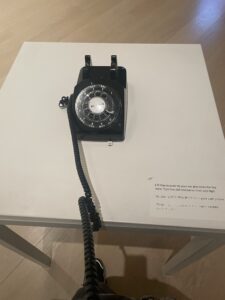

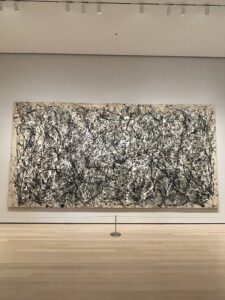

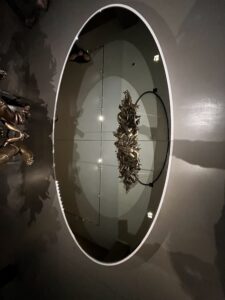

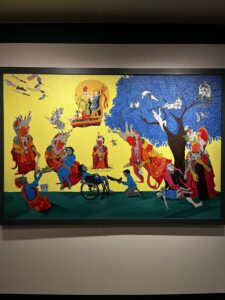 drawn to
drawn to 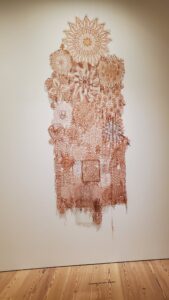
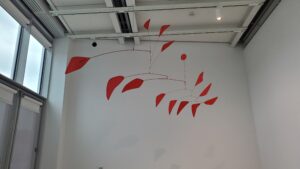 Other than that artwork, the rest of the floor had average paintings, landscapes, abstracts, and portraits, so I continued to the top floor.
Other than that artwork, the rest of the floor had average paintings, landscapes, abstracts, and portraits, so I continued to the top floor.
